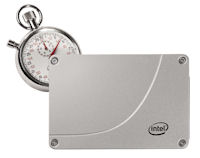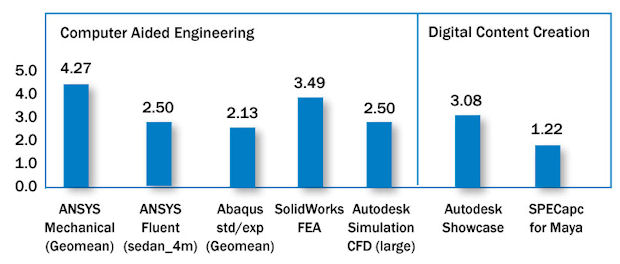6 Steps to Workstation Upgrades
Latest News
October 1, 2014
 With so many options and form factors to choose from, there is no such thing as one-size-fits-all professional workstation. A workstation purpose-built for engineering professionals needs to deliver the right mix of performance tuned to today’s 3D modeling and simulation applications with the ability to easily scale to meet future requirements.
With so many options and form factors to choose from, there is no such thing as one-size-fits-all professional workstation. A workstation purpose-built for engineering professionals needs to deliver the right mix of performance tuned to today’s 3D modeling and simulation applications with the ability to easily scale to meet future requirements.
So how does this directive translate into actual specs for an optimal workstation configuration? Alex Herrera, a consultant specializing in high-performance graphics and workstations, has laid out a simple set of guidelines that can help engineers discover the best system configuration for their workloads.
1. ISV certification is a must
More than anything else, a professional workstation must be reliable. With ISV certification, engineers are assured they can get their work done without disruption. If your workflow is heavily dependent on CAD modeling or involves simulation software, look for workstations that are certified by your software vendor.
The certification stamp means the workstation OEM and the software provider team have collaborated to put the various system configurations through exhaustive testing at both the system and board level. Through a series of regression tests, each workstation configuration—both hardware and software—is put through its paces and if results match previous benchmarks, the new configuration is deemed reliable and gets certified. Conversely, if errors are detected, the team works together to address bugs until the entire regression suite passes muster.
2. Strike a balance between core speed and core count
The typical multi-stage, multi-iteration CAD workflow or design analysis cycle is a test of workstation performance. Multi-threaded applications like rendering, finite element analysis (FEA) and computational fluid dynamics (CFD) all stand to benefit from modern multi-core CPU technology, which can parallelize tasks across multiple cores.
Yet many common CAD computing tasks—parametric modeling, for example—don’t see the same advantages from parallel execution on multiple cores. Instead, they benefit most from an investment in a superscalar CPU core running at the highest possible frequency. The rule of thumb, then, is to balance CPU spending on core speed and number of cores in the way that best meets the needs of your core design tools.
3. Invest in professional GPU power
Despite sharing some core hardware and software technologies, consumer-grade graphics solutions don’t hold a candle to professional GPU horsepower when it comes to meeting the needs of design engineers. Professional GPUs are optimized for CAD applications in terms of both performance and accuracy. Equipping a workstation with an uncertified consumer-grade GPU doesn’t just limit what you can do—it can lead to a dramatic dip in software performance that will hinder any engineers’ productivity.
4. ECC memory is key
Memory errors, while not common, can wreak havoc on an engineer’s productivity and cause serious project delays. Beyond providing the largest possible memory configuration, investing in Error Correcting Code (ECC) memory enables your workstation to detect and correct single-bit memory errors.
5. Opt for workstation-class storage technologies
Hard disk drives are fine for consumer or general office applications, but when it comes to the needs of engineering professionals, it’s time to turn to higher performance storage options. Solid state drives (SSDs) offer compelling advantages in performance and reliability and are becoming a cost-effective storage alternative. Small engineering organizations that manage their own IT should also consider adding RAID to their storage set-up as way to provide cost-effective data protection as well as a way to provide a potentially significant boost in performance.
6. Put a premium on expandability
The workstation you buy today will be better than systems available 12 to 18 months ago, but it will also likely need to be updated in the future to support new processing requirements. Because of this, ease of expansion is a key selection criteria—choose a workstation that can be easily upgraded mid-life via memory or storage expansion or with a new CPU or GPU in order to maximize the investment.
While there is no hard science to configuring the optimal workstation, these are clear guidelines to ensure you make the right choice. After all, a properly configured workstation is the consummate tool for engineers on the path to creative and innovative design.
A Workstation Checklist
In need of guidance to zero in on the optimal workstation? Consider the following questions to pinpoint a workstation model that will meet both your engineer and budget needs.
- Do I really need a workstation? Are doing full-blown CAD design or running simulation? Then the answer is “Yes.” Workstations are tested, optimized, and certified to run critical engineering applications and offer increased performance and productivity.
- What is the best processor fit? Buying a system equipped with a processor that’s one or two frequencies down from the top-of-line model allows for savings that can be directed toward other, less expensive technologies that can have a greater impact on performance.
- What’s the optimum memory configuration? The rule of thumb is to equip a system with twice as much memory as the largest model you are working with.
- What should I choose for graphics? If your day-to-day work involves non-linear editing or you handle extremely large graphics models, invest in a system with a top-of-line GPU. A mid-range or entry-level professional graphics card will deliver more than adequate performance for common CAD modeling tasks.
- What kind of storage is appropriate? Engineering users can greatly benefit from the added performance of solid state disk drives (SSDs), which are a staple of most workstations. They deliver noticeable performance when opening and closing multiple files and working with large data sets.
This content is sponsored by Intel.
Subscribe to our FREE magazine, FREE email newsletters or both!
Latest News
About the Author
DE’s editors contribute news and new product announcements to Digital Engineering.
Press releases may be sent to them via [email protected].







 Everyone talks about the need for speed, but there’s more to boosting performance than a faster processor. Solid state drives (SSDs) can radically improve performance of CAD applications. Case in point: In tests, SolidWorks reseller CATI was able to boost the performance of SolidWorks by 47% by replacing the 7200 RPM hard drive with an SSD. Further optimizing the hard drive configuration saved two hours and 13 minutes on operations—a 56% improvement.
Everyone talks about the need for speed, but there’s more to boosting performance than a faster processor. Solid state drives (SSDs) can radically improve performance of CAD applications. Case in point: In tests, SolidWorks reseller CATI was able to boost the performance of SolidWorks by 47% by replacing the 7200 RPM hard drive with an SSD. Further optimizing the hard drive configuration saved two hours and 13 minutes on operations—a 56% improvement.
 Engineers reliant on simulation or photorealistic imaging software can’t afford performance delays from an inadequately-specked workstation. They will see significant performance gains with a workstation based on the most current dual socket Intel® Xeon® Processor E5-2687W v3 compared to a system configured with the latest single socket Intel® Xeon® Processor E5-1680 v3.
Engineers reliant on simulation or photorealistic imaging software can’t afford performance delays from an inadequately-specked workstation. They will see significant performance gains with a workstation based on the most current dual socket Intel® Xeon® Processor E5-2687W v3 compared to a system configured with the latest single socket Intel® Xeon® Processor E5-1680 v3.